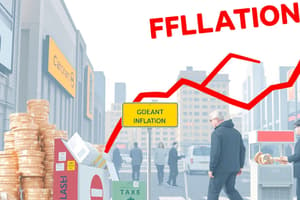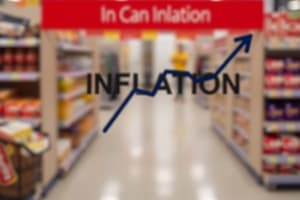Podcast
Questions and Answers
What effect do downward sticky prices have on firms when total spending unexpectedly decreases?
What effect do downward sticky prices have on firms when total spending unexpectedly decreases?
- Firms shift toward non-durable goods production.
- Firms increase production to compensate for losses.
- Firms can lower prices to maintain sales.
- Firms will end up selling less output. (correct)
Which type of economic shock is primarily related to unexpected changes in resource availability?
Which type of economic shock is primarily related to unexpected changes in resource availability?
- Political events
- Productivity changes (correct)
- Monetary factors
- Irregular innovation
During what economic cycle phase do durable goods typically experience the most significant impact from shocks?
During what economic cycle phase do durable goods typically experience the most significant impact from shocks?
- Contraction phase (correct)
- Trough phase
- Peak phase
- Expansion phase
What was a significant cause of the recession in 2007 as per the outlined shocks?
What was a significant cause of the recession in 2007 as per the outlined shocks?
Which of the following is NOT a common cause of economic shocks?
Which of the following is NOT a common cause of economic shocks?
What is one likely consequence when firms face downward sticky prices during a recession?
What is one likely consequence when firms face downward sticky prices during a recession?
Which category of goods tends to be affected least by economic shocks?
Which category of goods tends to be affected least by economic shocks?
What happens to GDP when firms cut back on production due to sticky downward prices?
What happens to GDP when firms cut back on production due to sticky downward prices?
What causes demand-pull inflation?
What causes demand-pull inflation?
Which of the following is a likely consequence of rising inflation rates?
Which of the following is a likely consequence of rising inflation rates?
Which statement best describes sticky prices in the context of inflation?
Which statement best describes sticky prices in the context of inflation?
What is one likely effect of excessive spending relative to output?
What is one likely effect of excessive spending relative to output?
Which of the following scenarios could lead to an economic shock?
Which of the following scenarios could lead to an economic shock?
What is the primary effect of inflation on money?
What is the primary effect of inflation on money?
What is a primary factor that could lead to cost-push inflation?
What is a primary factor that could lead to cost-push inflation?
How is the Consumer Price Index (CPI) calculated?
How is the Consumer Price Index (CPI) calculated?
What percentage rise in prices occurred between years 1 and 2, given the CPI values?
What percentage rise in prices occurred between years 1 and 2, given the CPI values?
Using the Rule of 70, how many years will it take for the price level to double if the inflation rate is 2.4%?
Using the Rule of 70, how many years will it take for the price level to double if the inflation rate is 2.4%?
Which option best describes how inflation can impact the business cycle?
Which option best describes how inflation can impact the business cycle?
What would be the estimated time for the price level to double at an inflation rate of 7% using the Rule of 70?
What would be the estimated time for the price level to double at an inflation rate of 7% using the Rule of 70?
Which of the following is NOT a direct consequence of high inflation?
Which of the following is NOT a direct consequence of high inflation?
What is the formula for calculating the Consumer Price Index (CPI)?
What is the formula for calculating the Consumer Price Index (CPI)?
Which of the following best describes ‘sticky prices’?
Which of the following best describes ‘sticky prices’?
Which situation is likely to occur as a result of inflation?
Which situation is likely to occur as a result of inflation?
Flashcards are hidden until you start studying
Study Notes
Inflation
- Inflation is defined as the general rise in the price level.
- Inflation reduces the purchasing power of money.
- The consumer price index (CPI) is used to measure the price of a typical market basket of goods and services purchased by consumers.
- The CPI is calculated by dividing the price of the market basket in the most recent year by the price of the market basket in a base year and multiplying the result by 100.
Rule of 70
- The Rule of 70 is a shortcut to calculate the number of years it takes for the price level to double.
- To use the Rule of 70, divide 70 by the percentage rate of inflation.
Demand-Pull Inflation
- Demand-pull inflation occurs when spending increases faster than production.
- This could happen when the central bank issues too much money.
- Prices rise due to excess spending relative to output.
Cost-Push Inflation
- Cost-push inflation occurs when there is a rise in per-unit production costs.
- This increase in costs forces businesses to raise prices to maintain profitability.
Economic Shocks
- Economic shocks are unexpected events that individuals and firms may have trouble adjusting to.
- When total spending unexpectedly decreases, firms may not be able to lower prices due to price inflexibility.
- This can lead to a decrease in sales and production, ultimately causing GDP to fall.
Causes of Economic Shocks
- Economic shocks can be caused by:
- Political events like wars
- Financial instability, such as the recession of 2007
- Irregular innovations, such as the development of the computer and the internet
- Productivity changes, such as unexpected changes in resource availability
- Monetary factors, such as the central bank printing too much money.
Cyclical Impact
- Durable goods are affected most by the business cycle:
- Capital goods (such as machines and factories)
- Consumer durables (such as cars, houses and jewelry)
- Nondurable consumer goods are affected less:
- Services (such as banking and healthcare)
Calculating Inflation Rates
- Find the difference between the CPI in two different years:
- Divide this difference by CPI in the earlier year
- Multiply by 100 to get the percentage change in prices.
Studying That Suits You
Use AI to generate personalized quizzes and flashcards to suit your learning preferences.




